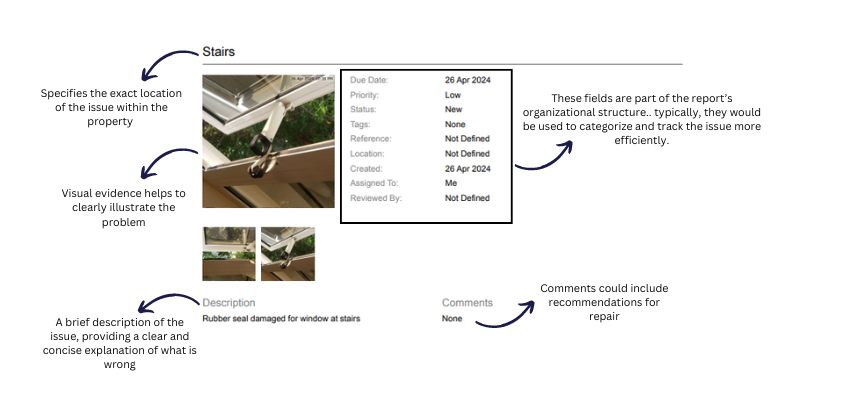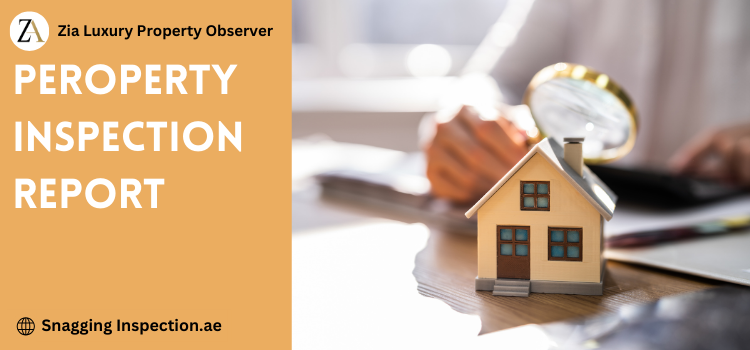A Property inspection report is a crucial document for buyers, real estate agents, and homeowners. It provides a detailed evaluation of a property’s condition, helping identify potential issues and estimating repair costs. Understanding the components of an inspection report is essential for making informed decisions during property negotiations.
A Property inspection is a thorough examination of a house’s condition, typically performed by a certified Property inspector. The goal is to uncover any defects or potential problems within the property. The findings are then compiled into a report, which serves as a critical tool for buyers and sellers alike.
Componentsof an property Inspection Report
General Information
1. Report: The report starts with general information about the inspection, including the inspector’s details,project details, inspection date, and property address.
2. Buyers: It may also list the intended recipients of the report, often the buyers and their real estate agent.
Property Descriptions
This section provides a summary of the property’s building, interior, and exterior features. It includes descriptions of rooms, layouts, and significant characteristics.
Home Inspection Checklist
The home inspection checklist covers all areas inspected. It includes sample checks for various components like appliances, doors, plumbing, and more.
Detailed Observations
- Property Inspector : Both terms refer to the professionals who conduct the inspection. They provide detailed observations on the condition of the property.
- Contractor and Estimates: Observations may suggest involving a contractor for specific repairs and provide rough cost estimates.
Book your Inspection with us today.
Our expert team is ready to conduct a thorough assessment of your property, identifying any potential issues and providing you with actionable recommendations.
what are included in property inspection?
1. Exterior Components
- Roof: The inspector will check the roof’s condition, looking for missing or damaged shingles, signs of leaks, and the overall state of the roof covering.
- Gutters and Downspouts: These are inspected for proper installation and signs of damage or clogging.
- Siding: The inspector looks for damage, wear, or potential water intrusion issues.
- Foundation: Visible areas of the foundation are checked for cracks, settling, or other structural concerns.
- Windows and Doors: The inspector will assess the condition and functionality of all exterior windows and doors, checking for proper seals and any signs of damage or rot.
2. Interior Components
- Walls, Ceilings, and Floors: The inspector will look for signs of damage, cracks, or water intrusion in these areas.
- Doors and Windows: Inside, they will check that all doors and windows open and close properly and that seals are intact.
- Stairs, Railings, and Balconies: These are inspected for safety and structural integrity.
3. Major Systems
- Electrical System: The inspector examines the electrical panel, wiring, and outlets for safety hazards, proper installation, and functionality.
- Plumbing System: All visible plumbing, including pipes, fixtures, and water heaters, are inspected for leaks, corrosion, and proper function.
- HVAC System: The heating, ventilation, and air conditioning systems are checked to ensure they are operational and well-maintained.
4. Structural Components
- Attic: The inspector will look for proper insulation, ventilation, and signs of water damage or pest infestations.
- Basement and Crawl Spaces: These areas are checked for moisture, proper support, and any signs of structural damage or pest issues.
- Foundation: A thorough inspection is done to identify any structural issues such as cracks, settling, or water damage.
5. Appliances
- Built-in Appliances: The inspector will check the operation of built-in kitchen appliances, such as ovens, dishwashers, and garbage disposals.
- HVAC Equipment: Beyond basic functionality, they will check the age and condition of the furnace and air conditioning units.
- Water Heater: Inspected for proper installation, leaks, and functionality.
6. Safety Features
- Smoke and Carbon Monoxide Detectors: These are checked to ensure they are present and functional.
- Fireplaces and Chimneys: Inspected for structural integrity, proper installation, and potential hazards.
- Stair Railings and Decks: Ensured to be secure and up to code for safety.
7. Miscellaneous Components
- Insulation: The inspector checks the quality and quantity of insulation in the attic, walls, and other areas.
- Ventilation: Proper ventilation in the attic and other areas is assessed to prevent moisture buildup and other issues.
- Garage: The condition of the garage, including the doors and openers, is evaluated.
8. Potential Hazards
- Mold and Mildew: The inspector looks for signs of mold or mildew, which can indicate water damage and pose health risks.
- Pest Infestations: Any signs of pests, such as termites or rodents, are noted.
- Radon, Asbestos, and Lead: In some cases, additional testing for radon, asbestos, and lead may be recommended.
Download Property Inspection Report Template
What does a property inspection report look like?
The purpose of this section of the inspection report is to provide a detailed account of a specific issue identified during the property inspection. This includes visual documentation, a clear description, and relevant details to assist in understanding the nature and priority of the problem. This section serves the following key purposes:
- Clear Documentation: By providing images, descriptions, and priority levels, this section ensures that the issue is clearly documented and can be easily understood by homeowners, buyers, and contractors.
- Repair Planning: Identifying the priority and due date helps in planning and scheduling the necessary repairs. This ensures that the issue is addressed in a timely manner, preventing further damage or deterioration.
- Transparency: Detailed reporting fosters transparency between buyers and sellers. It ensures that all parties are aware of the property’s condition and can make informed decisions regarding negotiations and repairs.
- Accountability: Fields such as “Assigned To” and “Reviewed By” (if filled out) create accountability, ensuring that the issue is tracked and followed up on until it is resolved.

Let’s break down the purpose and components of this section to understand its significance.
Key components of the inspected area in inspection report
1. Images:
The provided images visually document the issue, showing the exact condition of the damaged rubber seal. Visual evidence helps to clearly illustrate the problem, making it easier for all parties to understand the extent of the damage.
2. Due Date:
This date indicates when the issue was noted or when it is recommended to be addressed by. Setting a due date helps prioritize the repair and ensures that it is not overlooked.
3. Priority:
Low: The priority level indicates the urgency of the repair. A “Low” priority suggests that while the issue should be addressed, it is not critical and does not pose an immediate risk to the property’s safety or functionality.
4. Status:
New: The status indicates that this is a newly identified issue that has not yet been resolved.
5. Tags, Reference, Location, Created, Assigned To, Reviewed By:
These fields are part of the report’s organizational structure. While they are marked as “Not Defined” or “None” in this instance, typically, they would be used to categorize and track the issue more efficiently. For example:
6. Tags: Could include keywords for easier search and categorization.
7. Reference: An identifier for tracking the issue within the report or repair system.
8. Location: Specifies the exact location of the issue within the property (e.g., “Window at stairs”).
9. Created: The date the issue was documented.
10. Assigned To: Indicates who is responsible for addressing the repair.
11. Reviewed By: Indicates if the issue has been reviewed by a supervisor or another inspector.
12.Description: Rubber seal damaged for window at stairs: A brief description of the issue, providing a clear and concise explanation of what is wrong. This description helps anyone reviewing the report understand the specific problem without needing to refer solely to the images.
13. Comments: None: This section is available for additional notes or observations but is empty in this case. Comments could include recommendations for repair, potential consequences of not addressing the issue, or further observations made during the inspection.
Conslusion
In the end, a thorough home inspection and a clear, detailed report provide the transparency and insight needed to make informed decisions, ensuring that your investment is sound and that any necessary repairs are addressed before closing the deal. This diligence helps to safeguard your financial interests and ensures peace of mind as you move forward in your home-buying journey.


